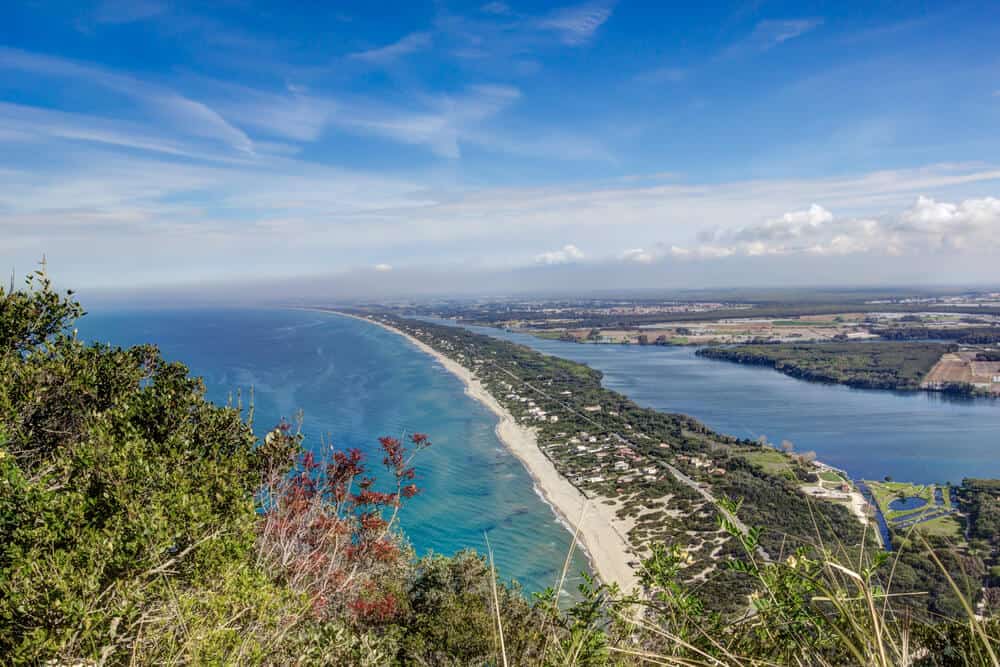Escape to the seaside
Rome may be gorgeous, but sometimes we need a break and some fresh sea air. Just a 90-minute drive south of the Eternal City is an expansive sandy coastline of charming beach towns, calm waters and breath-taking sunset views. And it’s more than just fun in the sun as the southern Lazio coast offers outdoor lovers nature-filled adventures, and art aficionados full immersion in architectural and archaeological sites.
Sabaudia
The holiday beach town of Sabaudia is juxtaposed against the beautiful contrast of Lazio’s southern coast and the wild Circeo National Park. Take your pick from the number of beach clubs set up along the expansive stretch of sand and slather on that SPF! Make sure to also take note of the town’s architectural pearls, as sun and surf aren’t the only elements Sabaudia has to offer.

Once Agro Pontino marshland, it took Mussolini just 253 days to drain and build Sabaudia, ensuring its place as the jewel of Italian rationalist architecture. The town features wide open spaces, well-defined roads and clean, strictly lined buildings. In the early 1900s, the town was home to many artists, poets, journalists and intellectuals, as well as many modern architects including Luigi Piccinato, Eugenio Montuori and Angiolo Mazzoni, whose striking Il Palazzo delle Poste is now a documentation centre.
Before going for a dip, make sure to take a peek at the magnificent Villa Volpi, located on the shores of Sabaudia. Immersed in 10 hectares of natural park overlooking the sea, the enormous neo-classical Venetian-Palladian style villa was commissioned by Countess Nathalie Volpi di Misurata, wife of the Venice International Film Festival’s founder, to architect Tommaso Buzzi and has been included in famous Italian films including Marcello Mastroianni’s Divorce Italian Style. Spend a leisurely day at the sea at Saporetti where you can rent a sunbed and enjoy a seaside lunch. The beach club lights up the summer nights with DJs and live music.

San Felice Circeo
Sabaudia’s equally charming neighbour San Felice Circeo is perched high on a hill just below Mount Circeo and the Acropolis of Circeo. The Temple of Circe is a fascinating archaeological site which was originally a pagan site of worship and contains remains of Roman villas.
According to legend, the delightful seaside resort was where Homer’s epic hero Ulysses was bewitched by the Sorceress Circe and imprisoned for over a year. During the summer months, San Felice is invaded by beachgoers, drawn by the town’s marvellous crystal-clear sea and picturesque town. Be sure to take in the panoramic views of the Pontine islands from Piazzale del Belvedere and check out local favourite Il Faro for dinner. If you’re extending your trip overnight, we highly recommend bed & breakfast Isola di Eea.
Terracina
The seaside town of Terracina is home to some gorgeous beaches but more importantly, a plethora of archaeological masterpieces including the Tempio di Giove Anxur. Located atop Monte Sant’Angelo, the first century B. C. temple was dedicated to the god Jupiter as a boy and a young man (hence the “Anxur” in the title) and included a boundary wall and towers to serve as military fortifications. When Romans built Via Appia in 312 B. C., the 560 kilometers basalt-lined road connecting Rome to Brindisi ran directly up the steep slope of Monte Sant’Angelo, which you can still see as you make your way down to Terracina vecchia, old Terracina, a maze of centuries-old houses leading to the historic centre.
Once you reach ground level, you’re in vibrant Terracina modern, a busy beach town packed during the warm months with visitors vying for lettini at any of the numerous stabilimenti, colourful beach establishments. Seafood lovers, go no further. Terracina is home to one of the best fish markets in Italy, Centro Ittico. Nothing much to look out, but then again, you’re there to eat.

Sperlonga
Sperlonga, oh, Sperlonga. This beautiful beach town has legendary origin story as the land of Aeneas and Ulysses, so it’s now wonder that Sperlonga is home one of the most beautiful archaeological sites in all of Italy,
Look down the shore line. On the coast are the remains of mystical grottos, which for centuries were mysterious refuges used by fishermen and peasants. The most famous is Grotto of Tiberius, part of the Villa di Tiberio. From 14 to 37 AD, Tiberius reigned as Emperor of Rome, an expanse which crossed seas and continents, and late in his reign, built a palatial villa extending over 300 meters of coastline, supposedly inspired by a project designed by Augustus. In 1957, Tiberius’ secret seaside villa was re-discovered in natural cave near Sperlonga and with it, life-size sculptures, which are now displayed in Sperlonga’s must-visit archaeological museum.
